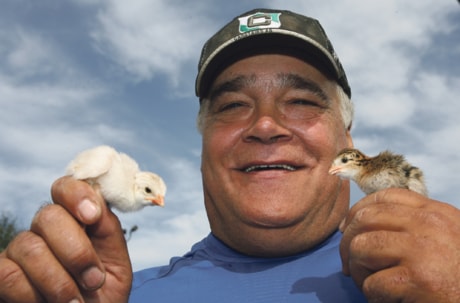Excited children and seniors who were reminded of their youth on the farm came to view a collection of barnyard creatures.
The newly formed Canadian Heritage Breeds organization held a sale and display in downtown Red Deer on Saturday of about 60 breeds of poultry birds and even a few rabbits.
Heritage Breeds is a group of livestock breeders focused on preserving heritage breeds, said an event organizer Liz Munro of Delburne.
Shannon DeBruin, a breeder from Wetaskiwin, said 30 to 35 breeders were present for the first ever event.
“The turnout has been great.
“Everyone’s got questions and they want to know about their favourites and such,” said DeBruin who grew up on a farm and always had poultry around.
“There’s been lots of questions about what birds make good pets,” she said.
Some farm birds can make great pets in the right situation, said Stan Warketenen, a senior who was roaming the displays with his wife Anne.
“We just love the sounds of the birds.
“It takes me back to the days when we had our own farm and kept many of these birds around us,” Stan said.
In addition to being an unusual conversation piece, pet poultry can also benefit a household.
Hens, for example, will produce eggs, and a roving team of chickens or geese can help fertilize a garden, eliminate pests and till the soil.
As a general rule, pet poultry should live outdoors, although it is possible to house-train farm birds, Stan said.
“But you’ve got to watch where you’re walking,” he laughed.
Munro said the idea of people keeping chickens in their backyards in the city is possible.
“Our city council is very forward thinking and very green thinking, which is great,” added Munro.
She said if it ever came up for council discussion, it would most likely require a bylaw change.
Other cities allow it. Backers in Calgary, for example, say hens provide eggs, eat pests and produce waste that’s good for the soil.
Roosters aren’t part of the equation.
DeBruin said a large percentage of the birds are heritage and rare breeds. They’re on the Rare Breeds Canada list, which means they number less than 100.
DeBruin said if the endangered birds are lost so too will be their genes — and there could come a time when the gene will save commercial flocks.
Replicating the genes in the lab isn’t the same, she said.
“All the birds carry different pieces of genetic information. What makes a purebred a purebred is that group carries that specific sequencing.”
Melissa Ducette, a seven-year-old, was thrilled with a classic red rooster cage. “I like them so much, I hope my mommy buys me one,” she said.
Poultry is a generic term used to refer to domesticated birds that are bred for their eggs and meat.
Ducks, peacocks, chickens, guinea fowl, geese, and turkeys are all classified as poultry. Not all poultry is suitable for adaptation as a pet. Small birds like ducks and chickens make good potential companions, while geese and turkeys are less advisable.
Peacocks and guinea fowl are noisy and messy, making them poor choices for pets.
In terms of chickens, females make the best pet poultry because they tend to be more docile, trainable and agreeable.
Female and male ducks make acceptable pets, Anne added.
jwilson@www.reddeeradvocate.com
